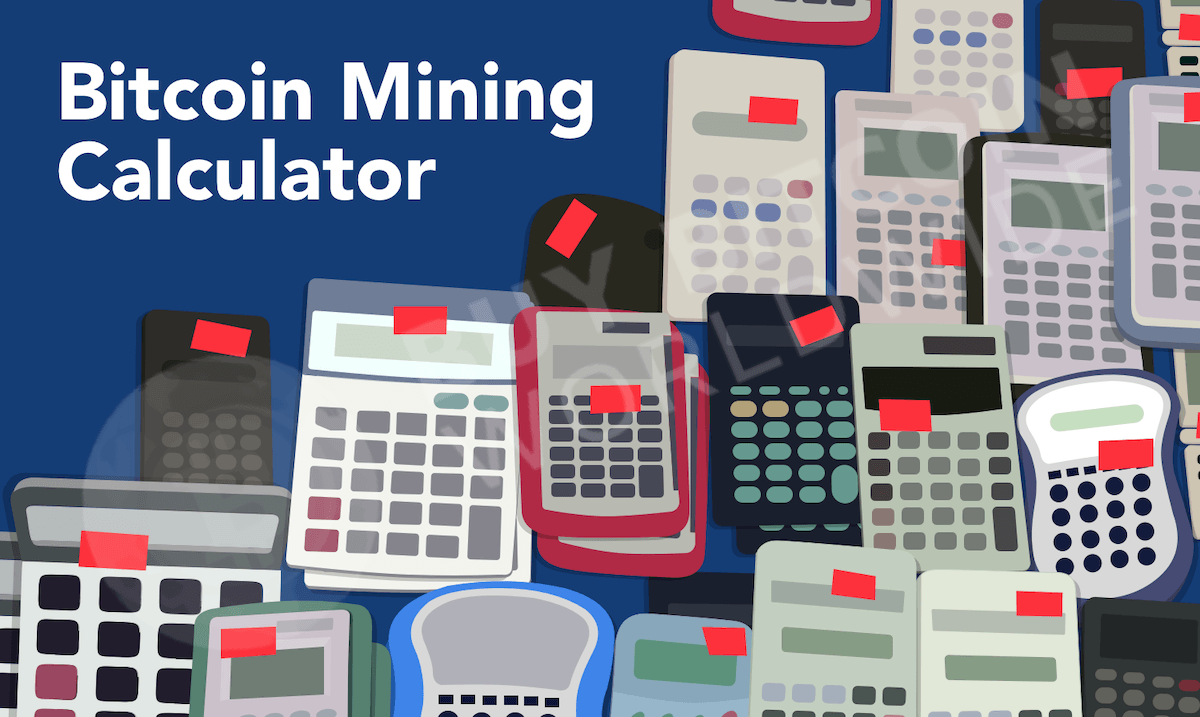Why Our Calculator is the Most Accurate
There are many factors that affect your mining profitability. Two of the main factors that influence your profitability are:
- The Bitcoin price and the total network hash rate.
- The Bitcoin network hash rate is growing at a rate of 0.4527678% per day. This means if you buy 50 TH/s of mining hardware your total share of the network will go DOWN every day compared to the total network hash rate.
➤ MORE: Is bitcoin mining profitable in 2023?
Our calculator assumes the 0.4527678% daily increase in network hash rate that has been the average daily increase over the past 6 months.
Without factoring in this growth, most Bitcoin mining calculators show results that appear MUCH, MUCH more profitable than reality.
How to Use Our Calculator
In order to use our calculator, all you need to do is plug in your miner's hash rate and power consumption as well as your electricity cost into the form.
If you have many miners, then you can multiply the hash rate and power consumption by the number of miners you have. Or just fill the form in for one miner, and then multiply that number by the number of miners you have.
Obviously, if you have many different kinds of miners you are deploying, you will need to run this calculation for each one.
➤ MORE: Bitcoin mining pools & sites
Bitcoin Mining Calculator Inputs
What our Calculator Assumes
Since our calculator only projects one year out, we assume the block reward to be 6.25. We also use the current mining difficulty in our calculations.
| Bitcoin Mining Difficulty |
Bitcoin Block Reward |
| 55,621,444,139,430.00 |
6.25 BTC |
What is Configurable in Our Calculator
Below are the inputs that require input from you. We do fill in the current Bitcoin price for you, however you can change it if you want to see scenarios using a different Bitcoin price.
| Configurable Inputs |
| Hashrate |
Bitcoin Price |
Power consumption (watts) |
Electricity Costs |
➤ MORE: Bitcoin mining machines & hardware
Top 5 Bitcoin Mining ASICs 2023
| Model |
Hashrate (TH) |
Power Consumption (watts) |
Price per Unit (USD)[1] |
Profitability per Year (USD)[2] |
| Antminer S19 XP |
138TH |
3250 watts |
$3,629 |
$2,588 |
| Whatsminer M50S+ |
140TH |
3500W |
$4,760 |
$2,494 |
| Whatsminer M50S |
122TH |
3360W |
$3,399 |
$1,972 |
| Antminer S19j Pro |
97TH |
3250W |
$1,699 |
$1,193 |
| Antminer S19 Pro+ |
120TH |
5,445W |
$2,395 |
$553 |
[1] The prices of these ASICs are highly variable based on the amount you buy, current market conditions, and variations in region and vendor.
[2] Profitability in this table is calculated using an assumed power price of $0.075 / kWh. Profitability calculations are estimates and change based on factors like electricity costs, mining difficulty, and the Bitcoin price.

Factors That Affect Mining Profitability
Mining can be an effective way to generate passive income. However, there are numerous factors that affect mining profitability, and often times they are out of your control.
Some seem to believe they will be able to quit their nine-to-five job after investing in a few Bitcoin miners – unfortunately, that is not necessarily the case.
How do you know if mining is right for you?
It is important to understand the constantly changing dynamics that play into mining profitability, especially before you invest your hard-earned money. Nevertheless, a proper passive income can be generated if you play your cards right. Let's explore the factors that you need to consider before you buy mining hardware:
The Bitcoin Price
Even though an increase in the network hash rate will cause your share of the network hash power to go down, the Bitcoin price can help make up some of these losses if it goes up.
The Bitcoin price is rising at slightly less than 0.3403% per day on average over the past year. We suggest you enter a custom Bitcoin price into our calculator based on what you expect the average price to be over the next year.
The price has gone down for most of the past year, which is a factor that should be strongly considered in your calculations.
Initial Investment
The initial investment in efficient mining hardware is probably one of the things keeping you from pulling the trigger, and for good reason. Mining hardware is expensive!
In actuality, the high cost of dedicated mining hardware ASICs (Application Specific Integrated Circuits) is largely to blame for the centralization of Bitcoin mining in China.
In case you were not aware, the vast majority of mining operations are in China, primarily because of cheap electricity (more on that later.) Since ASICs are expensive, many average consumers do not have the capital to invest.
The result?
Large mining corporations operate mining farms with thousands of ASICs. The average Joe can't even afford one ASIC, much less thousands of them.
Instead of mining being spread out across the world, the validation process is controlled by fewer people than first anticipated upon Bitcoin's inception.
ASICs' impact on Bitcoin aside, it is important to determine your ROI timeline before investing. Some hardware might not pay itself off at all. The additional factors below are largely responsible for determining your ROI period.
You can use the calculator above to determine your projected earnings based on the ASIC you're using, and your electricity cost.
Block Rewards and Transaction Fees
Every time a block is validated, the person who contributed the necessary computational power is given a block reward in the form of new-minted BTC and transaction fees.
Bitcoin's block time is roughly 10 minutes. Every 10 minutes or so, a block is verified and a block reward is issued to the miner. When Bitcoin was first created, miners received 50 BTC for verifying a block. Every 210,000 blocks – roughly 4 years – the amount of BTC in the block reward halves.
50 BTC per block may seem high, but it is important to consider the price of Bitcoin at that time was much less than it is today. As the Bitcoin block reward continues to halve, the value of Bitcoin is predicted to increase. So far, that trend has remained true.
First, the amount of newly minted BTC (often referred to as coinbase, not to be confused with the Coinbase exchange) halved to 25 BTC, and the current coinbase reward is 12.5 BTC. Eventually, there will be a circulating supply of 21 million BTC and coinbase rewards will cease to exist.
If BTC is no longer minted, mining won't be profitable anymore, right?
Wrong.
Bitcoin transaction fees are issued to miners as an incentive to continue validating the network. By the time 21 million BTC has been minted, transaction volume on the network will have increased significantly and miners' profitability will remain roughly the same.
Of course, block rewards have a direct impact on your mining profitability, as does the value of BTC – since the value of BTC is volatile, block rewards will vary. Additionally, successfully confirming a block is the only way you will generate any revenue whatsoever by mining.
Hashrate
On a simple level, the hashrate of a miner just tells you how many guesses the miner can make per second.
The higher the hashrate of an individual Bitcoin mining machine, the more bitcoin that machine will mine. Typically, a higher hash rate requires more energy, but that is not always the case. Some machines have the same hash rate but require different amounts of energy to power. That's because one may be newer and therefore more efficient with its power consumption.
All you really need to know is: a higher hashrate for the same amount of power consumption is always better.
Mining Difficulty
Mining difficulty is the final factor that will affect your profitability.
Difficulty is a variable that determines how hard it is for a miner to find a block. It is adjusted up and down algorithmically by the Bitcoin network based on the network wide hashrate - the sum of all miners' hashrates on the entire network.
If total network hashrate goes up, difficulty will increase, and your profitability will decrease.
If total network hashrate goes down, difficulty will decrease, and your profitability will increase.
This increase happens approximately once every two weeks.
Disclosure: Mining metrics are calculated based on a network hash rate of 346,968,946,852 GH/s and using a BTC - USD exchange rate of 1 BTC = $ 26,026.50. These figures vary based on the total network hash rate and on the BTC to USD conversion rate. Block reward is fixed at 6.25 BTC . Future block reward and hash rate changes are not taken into account. The average block time used in the calculation is 599 seconds. The electricity price used in generating these metrics is $ 0.12 per kWh. Network hash rate varies over time, this is just an estimation based on current values. "




